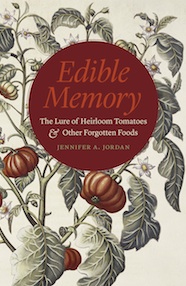By Colin Rafferty
Although not nearly as visible as the automobile, the airplane, and the computer, surely the most significant technological advancements of the 20th century include the advances in agriculture that allowed a majority of Americans to stop producing their own food. Only in the last decade have we begun to consider the industrial sources of this food on our plates, and a not-inconsiderable market has appeared for heirloom fruits and vegetables, plants grown from old varieties of seeds and rootstock. Unlike those chosen for their shelf appearance and stability in shipping, these heirloom vegetables promise better tastes, a wider selection, and a connection to a past way of life—a slower, occasionally more fragile way putting us in touch with previous generations.
So argues Jennifer Jordan, a sociologist at the University of Wisconsin-Milwaukee, in Edible Memory, a thorough exploration of the social meaning of these plants. Beginning with more prominent foods like tomatoes and apples, but careful not to miss more obscure varieties of heirlooms, Jordan considers the significance of contemporary desire for these plants, and the possible reasons why we might look back to them at this point in time.
Jordan’s role as a sociologist means that her assertions about heirloom vegetables are backed by quantitative data. She tracks mentions of these foods in the mass media, which is how the reader learns that heirloom tomatoes were mentioned in 2,258 articles over a twenty-five year span. Sections like this serve a dual purpose: they reinforce the academic nature of Jordan’s study—no casual science, this—and they demonstrate the way that these vegetables, and perhaps more importantly, our understanding of these vegetables as “heirlooms,” have crept into our everyday lives.
Edible Memory is a decidedly academic book. Over one hundred pages—one third of the book—are given over to notes, bibliography, and an index. However, Jordan engages the reader with personal narrative throughout, using her own experiences at a Chicago farmer’s market as well as her own family history to illuminate the more data-driven trends she explores. These narratives never risk overwhelming the analytic dominance of Jordan’s approach. Perhaps there’s something lost in this—after all, taste is an incredibly subjective sense, and a more personality-drive approach to a study of heirloom foods might do more to account for the myriad ways they’ve affected the culinary markets.
Such a critique may be—pun intended—small potatoes. Whether you’re reading Edible Memory for bits of trivia for your next dinner party (Marie Antionette wore potato flowers in her hair), for the fascinating pre-Internet networks of seed traders who preserved thousands of varieties, or for a more nuanced understanding of the racial and class aspects of heirloom foods, Jordan’s book provides the opportunity for readers to develop their own insights. If we’re thinking more and more about the food we eat, despite not cultivating it ourselves, then Jordan’s book is a vehicle by which we might develop our conversations about this subject. These old foods have new meanings, and Jordan carefully unpacks them to illuminate what the earth brings forth. Underneath its academic surface, Edible Memory explores an increasingly prominent, deceptively complex topic, and Jordan’s precision in research serves her project well in answering the questions she asks.
Colin Rafferty (ΦBK, Kansas State University, 1998) teaches nonfiction writing at the University of Mary Washington in Fredericksburg, Virginia. Mary Washington is home to the Kappa of Virginia Chapter of Phi Beta Kappa.




